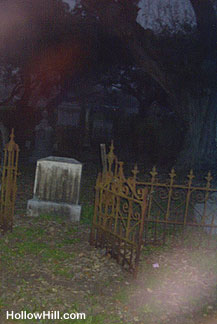As an Amazon Associate I earn from qualifying purchases. Click for details.

Ectoplasm? I’m not sure what caused the odd misty areas in the unretouched photo at left. (And, to be honest, I’m not sure anyone knows what ectoplasm is. We usually use the term to mean an expansive area of colorful, translucent energy.)
Look for the whitish, pink, and red areas in the photo. I have no explanation for any of those anomalies. They remind me of the colorful orb-ish shapes in the anomalies at New Orleans’ Jackson Square.
The photo was taken with a tripod and a delayed shutter. I stood to the side of the camera. When the flash went off, I could clearly see anything that might have been in front of the camera.
In other words, I didn’t see any bugs to explain these odd, colorful areas.
There was no chance of a camera strap, jewelry, or hair reflecting light on the lens. Also, since I was over five feet away when the photo was taken, it’s not breath.
I took over 200 photos in this cemetery, and none of them show insects. As usual, I’d looked for bugs before taking any photos. I saw none except the mounds indicating fire ants. (I was in sandals and kept my distance.)
The Columbus City Cemetery — also called Old City Cemetery — is on Walnut Street in Columbus, Texas, not far from the middle of town. In 1870, it was deeded to the city as an existing cemetery.
No one is certain how old the graves are, but the earliest headstone is dated 1853.
This wasn’t the first time I’d seen non-orb anomalies in Columbus photos. I’d seen possible ecto in a photo taken during a “Live Oaks and Dead Folks” tour, a popular annual event in Columbus, Texas.
This is an especially interesting cemetery. Many of the grave markers were washed away in a flood at the end of 1913. Disturbed graves could explain the recurring fog-like mist or ectoplasm in photos. There are at least 500 unmarked graves there.
This cemetery also contains the grave of Jonathan W. Sargent (1877 – 1929), who was killed in a car accident near Columbus. He’d assisted Howard Carter in Egypt, and may have been a victim of the famous “curse” of King Tutankhamen’s tomb.
In addition, the cemetery was the final resting place of many Confederate soldiers, as well as victims of the 1873 yellow fever epidemic.
Any one of these could account for higher-than-average paranormal activity in this lovely cemetery.
I recommend this cemetery for ghost enthusiasts, but only during daytime hours. After dark, uneven ground and the possibility of snakes make investigations treacherous.
The cemetery is patrolled regularly by police, who visited while I was there. Day and night, they can see activity in the cemetery from at least three nearby roads, so don’t expect to escape notice when you’re in the cemetery.
Since Columbus Cemetery’s orbs can be photographed in daylight, an early morning or late afternoon visit could be worthwhile.
